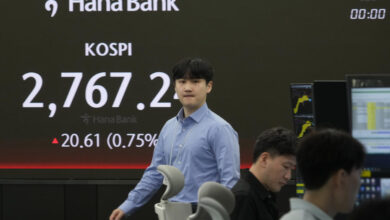The tango of bond prices and interest rates – Twin Cities


The Federal Reserve is in the news every day as new information pushes expectations of its future actions one way or another.
One positive economic indicator is announced, say on inflation, and pundits assert that the Fed now will ease up on the money supply, letting interest rates fall. This purportedly will push up prices of real estate, stocks and bonds.
Then another indicator is announced, say a positive report in itself, such as on job gains, but that motivates market watchers to predict that the Fed will be less likely to cut interest rates. Asset prices fall.
Sometimes it seems good news is bad news. What is going on?
Given the state of politics in our nation, military conflict in Eastern Europe and the Middle East, and China’s difficulties in stabilizing its financial markets and maintaining its usual growth, one can understand why financial markets are edgy. To use the memorable words of country singer Tennessee Ernie Ford, financial markets, especially those for bonds, are “as nervous as a long-tailed cat in a room full of rocking chairs.”
Better public understanding of what is going on is useful and there is no better place to start than the relationship between bond prices and interest rates.
A ”bond” is just a standardized IOU that documents a loan of money from one party to another and specifies how interest on that loan will be paid plus the eventual repayment of principal. In this general sense it is no different than a promissory note for a car loan or a home mortgage.
Bonds are said to be “issued.” All that means is the “issuer,” whether it be a corporation, a state or municipality or the federal government, is asking households or businesses to lend it money. If anyone with spare cash “buys” a bond, they turn over their money to the issuer and get an IOU in return. Decades ago it would have been a fancy piece of paper. Now it is just an entry in database.
The most common sort of medium- and long-term bonds is a “coupon bond.” It promises period payments of interest, usually annually, and return of principal at the end of a set period.
You may offer bonds that will “mature,” or return principal, in 10 years. They will pay 6% interest a year. So I “buy” one of your bonds by lending you $1,000 this month. For nine years, 2025 through 2033, you will pay me $60 interest. In the 10th year, 2034, you will pay me $1,060. That comprises the last $60 in interest and the return of the $1,000 in principal.
Bonds are legally standardized, so if your circumstances change, you don’t have to wait until 2034 to get cash. The original issuing of your bond involved “underwriting” in a “primary market.” But there are “secondary markets” for bonds in which ones that are not yet “mature” can be bought and sold. If you need cash faster, offer your bond in such a market. There will be a buyer at once.
However, there is no guarantee that you will get $1,000 for your bond. Its “price” in such a secondary market may be above or below its face, or “par,” value depending on what has happened to interest rates since its initial issue.
Now let’s look at what’s going on today. Suppose you bought your bond by paying $60 a year five years ago. Since then, to keep inflation in check, the Fed tightened the money supply effectively raising interest rates. We’ve all read about that. So your bond offers five $60 annual interest payments, plus $1,000 at maturity. But with interest rates now at 8%, prospective bond buyers could opt for a new five-year bond paying that rate. You’ll now have trouble selling on the secondary market.
If new buyers can get five $80 payments plus return of $1,000 principal from buying a new bond, why would they want your “seasoned” one offering $60 payments plus return of principal? They won’t. You will not find a buyer for your bond unless you are willing to sell it at a “discount” from its par or face value. At some lower price, the actual rate of return, or “yield,” to a buyer of your bond will equal that possible from a newly-issued one maturing at the same time.
So whenever interest rates rise, whether from central bank action or public fears about global economic prospects, existing bond prices fall.
That happened in spades when the Fed, facing high post-COVID consumer inflation, belatedly began to tighten after a decade of low rates following the 2007-09 financial market debacle, during which time they loosened to free up more money. The higher interest rates meant that old bonds issued at low rates were dogs on the market.
The same thing had happened after President Jimmy Carter appointed Paul Volcker to chair the Federal Reserve Board of Governors in 1979. Carter’s object, like current Fed Chair Jerome Powell’s, was to reduce inflation.
Volcker accomplished this by sharply restricting the money supply. Short-term interest rates went as high as 22% and some Treasury bonds were sold with 14% interest for 30 years. After some years of tight money, inflation fell. Then, so did interest rates. Newly-issued bonds did not pay anything near $140 per $1,000 par value. So for the yield on bonds maturing at the same time to equalize, the market price of existing bonds had to rise.
Note that even if one pays a price above a bond’s par or face value in a secondary market, when that bond matures, you still will only get $1,000 in principal back. So if one bond paying 14% interest will mature in nine years and another one in four years, the price of the latter has to be less than the first one since there are fewer periods in which to enjoy large interest payments. The cold water of return of only $1,000 principal will be soon.
The interest rate on “fed funds,” or overnight loans between banks, has mostly been in the 2% to 5% range over the last 70 years. But in the immediate wake of the 2009 capital market crisis, the Fed pushed this rate below one-quarter of 1% and left it there until 2016. It rose to near 2.5% by 2019 but, with the outbreak of COVID, the Fed increased the money supply again pushing rates below a quarter-percent for two years. However, with rising inflation, it abruptly boosted the rate from .08% to 5.33% in less than two years. It had not been above 5% since 2007. With higher rates, secondary bond markets saw prices fall.
So now we are yo-yoing. A monthly announcement shows low inflation, the Fed can now ease up. Bond prices rise. A monthly jobs count shows a greater increase than expected, possibly fueling inflation, and now the Fed will not ease up. Bond prices fall. China increases its money supply to address its economic problems. Its lower interest levels bring down rates globally. Bond prices rise.
There has not been as much political and economic uncertainty for decades. Expectations will continue to yoyo. Indeed oscillations may worsen with the U.S. presidential campaign. So bond prices will likely remain volatile.
St. Paul economist and writer Edward Lotterman can be reached at stpaul@edlotterman.com.





